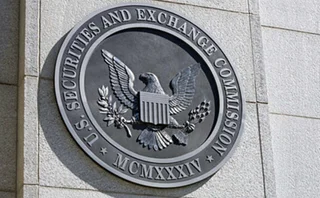
Profile: A business that's here to stay
The New York Stock Exchange has met with hostile press in recent years, criticising its outdated technology, overpaid executives and falling market share. But Paul Lyon finds its structured products business looking healthy

As Structured Products went to press the New York Stock Exchange (NYSE) was embroiled in one of its all too frequent scandals. Several former NYSE traders, who oversaw stock auctions on the exchange floor face indictment on charges that they traded to benefit their specialist firms at the expense of customers. And the US Securities and Exchange Commission is expected to file and settle charges against the NYSE, claiming the exchange did not properly police floor traders.
The news comes at a bad time for the exchange, the bastion of American capitalism. The NYSE reported net income of $24.6 million for the year ended December 31, 2004 compared to $49.6 million in 2003, and memories of Richard Grasso's $187.5 million pay package are still fresh in the mind. Grasso's replacement, NYSE chief executive John Thain, is now faced with expanding the exchange quickly enough to meet the demands of a rapidly changing global stock market as well as updating the exchange's technology and maintaining the NYSE's position. Some are suggesting that the institution should go public, and rumours are circulating that even if it doesn't, big changes are on the horizon.
Success
Susan Waiter, NYSE's managing director of structured products in the investment banking services group, refuses to be drawn on what the future may hold for the exchange, but appears comfortable in the knowledge that her department is enjoying considerable success. Waiter, who joined the NYSE in 2003, points out that while there were hardly any structured products available when the exchange launched the business in 1988, there are now 600 products available at any one time, and around 1,100 products have been launched in total. These products have a market valuation in excess of $125 billion, and the exchange claims it commanded a 94% share of all listed US structured products offerings in 2003.
Unlike the American Stock Exchange (Amex), the NYSE specialises in corporate issues. But like the NYSE, Amex has also noted an upswing in structured products activity, with listings there growing from 11 in 1995, 1996, and 1997, to 115 in 2004.
Last month, like many other US structured investment specialists, Waiter attended the Structured Products Association's annual conference in New York. Waiter notes that the association is a welcome development, useful for "strengthening relationships between issuers and attorneys". The conference also provided a forum for debating innovations in the growing US market, and while Waiter refuses to say which areas she thinks the NYSE might develop, she does say that clients of the exchange can expect some interesting launches in the near future.
And the NYSE, as well as Amex, is eagerly awaiting news of generic standards for exchange-listed structured products provided by the SEC. If approved, the development will mean the time to market for listed products could be significantly reduced for those whose features have already been listed. At the moment, each product has to be registered separately with the SEC, even if it is a carbon copy of a previous product.
Regulatory changes would certainly be helpful, but educating brokers about the advantages of structured products is even more important if the market is to grow further, Waiter says.
One obvious move for the NYSE would be to offer some form of equity derivatives business. The exchange lost out in this area, mostly to the benefit of Chicago, but many observers say the NYSE would do well to consider derivatives in its attempt to modernise. And while Waiter agrees that they would be a good fit with the existing structured products business, she again refuses to elaborate.
Only users who have a paid subscription or are part of a corporate subscription are able to print or copy content.
To access these options, along with all other subscription benefits, please contact info@risk.net or view our subscription options here: http://subscriptions.risk.net/subscribe
You are currently unable to print this content. Please contact info@risk.net to find out more.
You are currently unable to copy this content. Please contact info@risk.net to find out more.
Copyright Infopro Digital Limited. All rights reserved.
As outlined in our terms and conditions, https://www.infopro-digital.com/terms-and-conditions/subscriptions/ (point 2.4), printing is limited to a single copy.
If you would like to purchase additional rights please email info@risk.net
Copyright Infopro Digital Limited. All rights reserved.
You may share this content using our article tools. As outlined in our terms and conditions, https://www.infopro-digital.com/terms-and-conditions/subscriptions/ (clause 2.4), an Authorised User may only make one copy of the materials for their own personal use. You must also comply with the restrictions in clause 2.5.
If you would like to purchase additional rights please email info@risk.net
More on Regulation
Streamlining shareholding disclosure compliance
Shareholding disclosure compliance is increasingly complex due to a global patchwork of regulations and the challenge of managing vast amounts of data
Banks take aim at Gruenberg’s brokered deposit rule
Regulatory lawyers question need to reverse 2020 rulemaking just four years later
Time running out to backload Emir derivatives reporting
Significant slice of legacy trades still not ready for new formats, as October 26 deadline looms
Gensler to stick to Treasury clearing timetable
SEC chief promises to keep up the pressure for done-away trades
Clearing houses fear being classified as Dora third parties
As 2025 deadline looms, CCP and exchange members seek risk information that’s usually deemed confidential
Citizens’ growth won’t bow to regulatory thresholds, CRO says
Risk Live: Bank faces stricter capital and liquidity requirements if it crosses $250 billion in assets
FSB promotes convergence on operational incident reporting
As global body proposes common reporting format, official says there may be an optimum time window
SEC’s Peirce calls for US Treasury clearing delay
Risk Live: Current timeline impractical, commissioner warns; proposes task force to steer implementation







